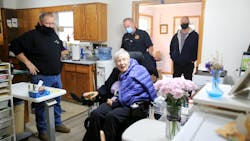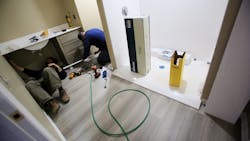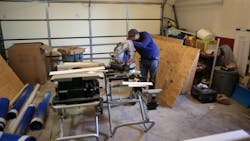FFs Remodel Home of OH Woman in Wheelchair after Fall
A medical call to the home of someone who helped develop an Ohio fire department's crisis stress management program prompted a group of firefighters to renovate the bathroom for the woman, who has been dependent on a motorized wheelchair for a decade.
“It was just an accident that I was on that run. I was working overtime out of Station 12 when the call came out. Injured in a fall. I knew the address. That’s Kay’s house," Lt. George Wallace, a veteran paramedic and EMS supervisor, stated in a Columbus Division of Fire social media post Wednesday.
The Kay who Wallace is refering to is Kay Werk, a woman instrumental in helping to formalize the creation of a team of peers in the department's Critical Incident Stress Management (CISM) program. Werk's contributions to the intervention protocol came after the line-of-duty death of firefighter John Nance in 1987, and it was an effort to help members better deal with the mental and emotional toll of that tragedy, as well as similar traumatic events in the future.
A group of firefighters banded together to renovate a bathroom in a modest, west-side ranch style home in November. It...
Posted by Columbus Division of Fire on Wednesday, February 3, 2021
Werk has had limited use or her left arm and leg following a serious stroke 10 years ago, and she needs a motorized wheelchair in order to live independently with the assistance of home health care professionals. In November, crews were called to Werk's house after she had fallen in her bathroom.
“She was wedged in the bathroom, trying to get out of her wheelchair and had fallen," said Wallace, who worked for years alongside Werk in the CISM program. "She had hurt her leg, and of course she didn’t want to be transported. But it started to swell, so we convinced her to go to the emergency room. An ER X-ray reviled the fracture."
The injury kept Werk in the hospital for firve days before she was moved to a rehab facility for 21 days. A positive COVID-19 test while at the rehab facility extended her time there, and she didn't return home until Jan. 18.
During the call, Wallace noticed the Werk's modest ranch-style house wasn't well-suited for a woman in a wheelchair, especially the tight dimensions of her bathroom. Her time away from home—more than two months—was enough of a window for Wallace and other firefighters to make some improvements.
“It was obvious her place was no longer safe, and not a good option for her," Wallace stated. "It was built in 1959, and not set up for a wheelchair. She’s at a point where she needs to make some hard choices about her living arrangements."
Wallace helped organize his fellow firefighters, who then reached out to construction supply businesses near Werk's house. He estimates that they received around $10,000 in donated materials alone.
“We only had a few weeks to pull this off. But word got out, and the phone just started ringing with offers to help,” he said. “One guy called another guy, who called another guy. … I had a friend who was in construction stop by and look at the house. He had fallen off a roof and was dependent on a wheelchair himself. The first thing he pointed out was the bathroom; it was way too small."
Taking these community contributions—including money from the Columbus Firefighters Foundation and the city's December 2012 fire recruit class—the firefighters knocked down a wall, installed a bigger, roll-in shower, lowered counters, replaced flooring and added safety rails throughout. Although she had signed off on the project and even went through carpet samples while she recovered, Werk wasn't prepared for the house she returned to last month.
“I’m just breathless. I can’t believe how pretty it all is. … If I could sing, I’d sing you all a song,” said Werk after a tour of her house during a small welcoming party in which firefighters hurried to reinstall a soap and shampoo dispenser.
“Everything takes longer in a wheelchair. But now I can roll into the shower, back it out and sit on a bench, and there’s a wonderful heater right in front of it, so it’s not a shock to get in there," she added. "It seems like a small thing, but I can now pull myself up to the sink, brush my teeth over a sink and a mirror I can actually use. It’s so much more dignified than brushing my teeth over a cup."
Werk also was impressed about the number of firefighters who helped on the project who hadn't known her while she was working with the department's CISM program.
“Firefighters know how to help one another," she said. "What is so astonishing about firefighters is the number different skills they have; electrician, plumber, painter and carpentry. Not just putting wet stuff on the red stuff. But the end result is always the product of cooperating. Together they are so much more than just one or two of them."
“All these people here to help me? It’s hard to find the words," she added. "It’s not undeserved help, but the sense of support and safety is so nice. The investment in time, energy and thoughtfulness by everybody. It’s overwhelming."
But in Wallace's mind, her contributions to the department through the CISM program have been life-saving.
“As a CISM peer, Kay’s probably saved more lives, more careers, than anyone in the fire service," Wallace stated. "I still send firefighters to her that would benefit from her help.
“We just wanted it to look like ‘home’ when she gets back here. I stopped sending pictures of the demolition, so it'll be like Christmas when it’s done. She kept asking me about the cost we were incurring. I kept putting her off. I knew she wouldn’t take any money from firefighters, either. She’d say they needed it more than herself.”


